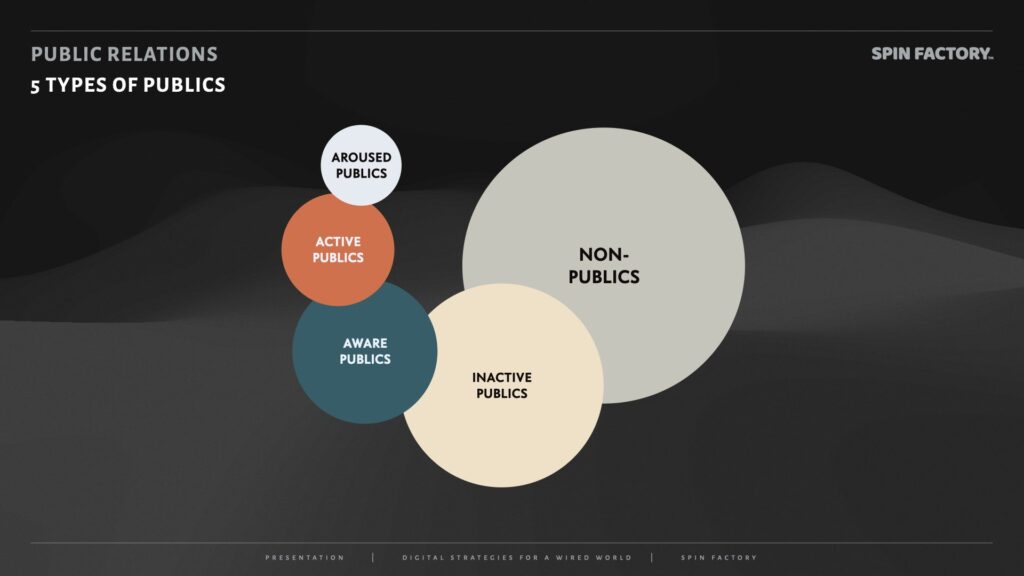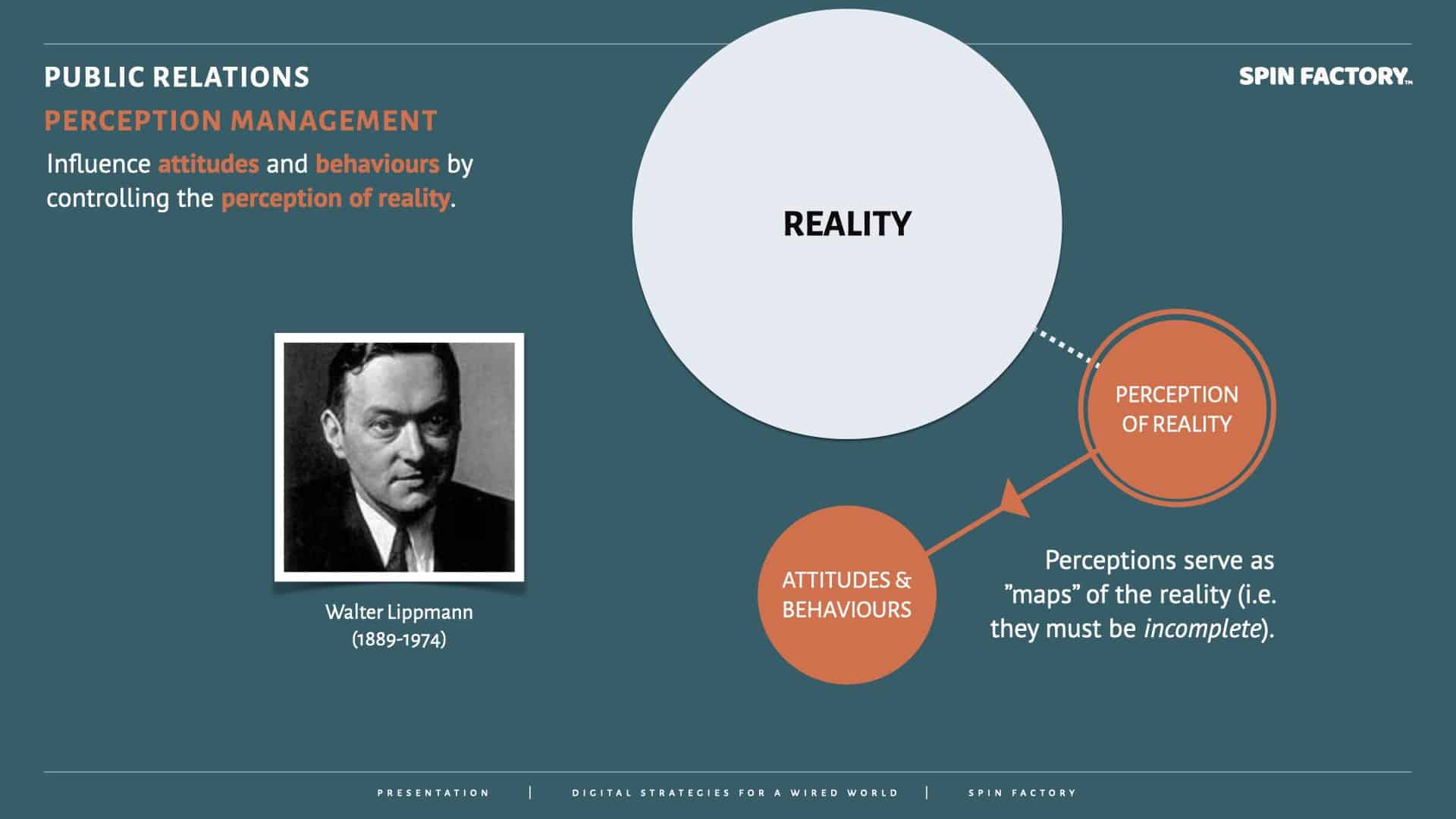What is public relations?
Hi! My name is Jerry. For over twenty years, I’ve supported 100+ brands strategically and tactically through public relations counsel and activities. I have Bachelor’s Degrees in Public Relations and Linguistics from Mid Sweden University.
I’ve compiled this article to give you an overview of public relations, help you understand the different parts of the profession, and answer your questions about PR.
Here we go:
What is Public Relations?
PR is often called Communications (or even Strategic communications) in many organisations.
In the corporate world, the PR function is often referred to as the ‘Communications Department,’ just as the advertising function is typically referred to as the ‘Marketing Department.’

Public relations professionals sometimes jokingly say that PR also stands for ‘Perception Management’ or ‘Personal Relationships.’
But—what is public relations?
The Public Relations Definition
The PR expert Rex F. Harlow once tried to gather all available definitions of public relations (PR), but he allegedly gave up after finding over 500+ different versions. 1From the early 1900s to 1976, Rex F. Harlow, a well-respected expert on public relations, gathered around 500 different definitions of public relations (Cutlip et al. 2006). 2Morris, T., & Goldsworthy, S. (2008). From PR to propaganda. 97 – 111. https://doi.org/10.1007/978 – 0‑230 – 59485-2_7
Amongst so many definitions of public relations, here’s the one that I find to be most useful:
Public relations (PR) = the strategic use of communication to establish and sustain productive brand relationships with publics, stakeholders, and influencers. 3Silfwer, J. (2015, November 7). What is Public Relations? Doctor Spin | The PR Blog. https://doctorspin.net/what-is-public-relations/
Please note:
Publics = psychographic segments (who) with similar communication behaviours (how) formed around specific issues (why) impacting a brand (to whom). 4Silfwer, J. (2015, June 11). The Publics in Public Relations. Doctor Spin | The PR Blog. https://doctorspin.net/publics-in-public-relations/
Stakeholders = representatives of various vested interests directly or indirectly connected to a brand. 5Silfwer, J. (2021, January 5). The Stakeholders in Public Relations. Doctor Spin | The PR Blog. https://doctorspin.net/stakeholders-in-public-relations/
Influencers = independent content creators with influential platforms and followings of potential importance to a brand. 6Silfwer, J. (2020, January 15). The Influencers in Public Relations. Doctor Spin | The PR Blog. https://doctorspin.net/influencers-in-public-relations/
Learn more: Public Relations Definition
The Publics in Public Relations
Publics are a central component of public relations — in fact, the ‘P’ in PR. However, they are often misunderstood or conflated with marketing’s ‘target groups’.
Here’s how to define publics in public relations:
Publics = psychographic segments (who) with similar communication behaviours (how) formed around specific issues (why) impacting a brand (to whom). 7Silfwer, J. (2015, June 11). The Publics in Public Relations. Doctor Spin | The PR Blog. https://doctorspin.net/publics-in-public-relations/
Please note:
Psychographic segment = similarities in cognitive driving factors such as reasoning, motivations, attitudes, etc.
Communication behaviours = how the public’s opinion is expressed (choice of message, rhetorical framing, and medium type).
Specific issue = determined situationally by a specific social object, often high on the agenda in news media or social media.
Learn more: The Publics in Public Relations
Five Types of Publics
There are plenty of inactive publics around us in society, just “waiting” for external situations to activate them and bring them together in coöperative, communicative behaviours.
However, PR tends to focus on the already activated publics:
“By focusing on activism and its consequences, recent public relations theory has largely ignored inactive publics, that is, stakeholder groups that demonstrate low levels of knowledge and involvement in the organisation or its products, services, candidates, or causes, but are important to an organisation.”
Source: Public Relations Review 8Hallahan, K. (2000). Inactive publics: The forgotten publics in public relations. Public Relations Review, 26(4), 499 – 515. https://doi.org/10.1016/S0363-8111(00)00061 – 8
Kirk Hallahan, Professor Emeritus, Journalism and Media Communication, Colorado State University, proposes five types of publics based on their knowledge and involvement: 9Hallahan, K. (2000). Inactive publics: The forgotten publics in public relations. Public Relations Review, 26(4), 499 – 515. https://doi.org/10.1016/S0363-8111(00)00061 – 8
Hallahan suggests a model based on knowledge and involvement:
As an organisation targeted by activists, what would be the best issue response? Hallahan proposes four principal response strategies: 10Hallahan, K. (2009, November 19). The Dynamics of Issues Activation and Response: An Issues Processes Model. Journal of Public Relations Research. … Continue reading
Learn more: Five Types of Publics
The Stakeholders in Public Relations
In public relations (PR), we often discuss stakeholders:
Stakeholders = representatives of various vested interests directly or indirectly connected to a brand. 11Silfwer, J. (2021, January 5). The Stakeholders in Public Relations. Doctor Spin | The PR Blog. https://doctorspin.net/stakeholders-in-public-relations/
The PR function is not just about managing media relations or marketing PR; it’s about comprehensively managing relationships with diverse stakeholder groups, each with unique information needs.
Different Information Needs
Why are stakeholders so important in PR?
Marketing is typically tasked with increasing an organisation’s sales of products and services. However, many other information needs must also be met.
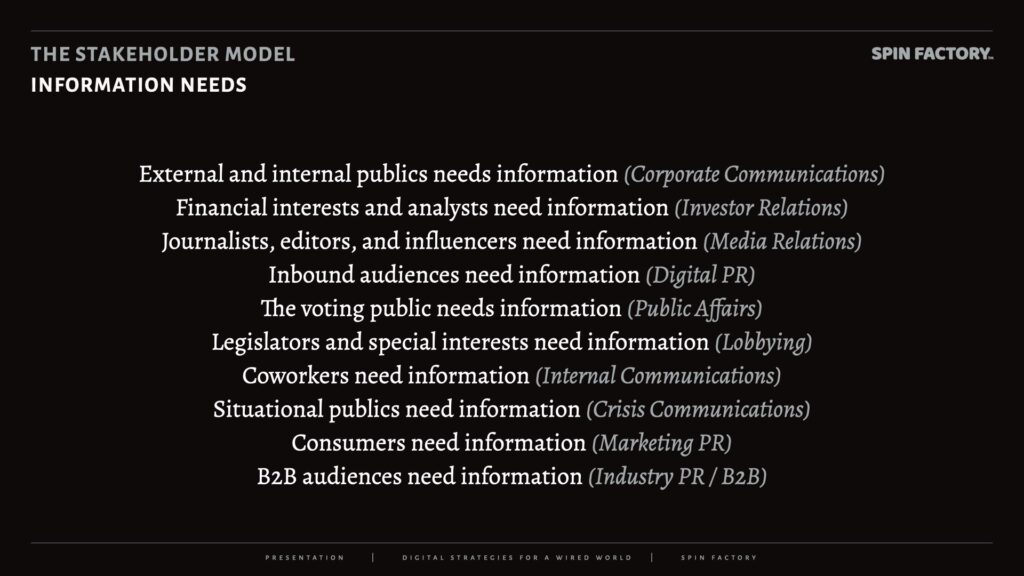
Establishing and sustaining relationships with various stakeholders is a significant challenge for PR professionals since their information needs are typically very different.
This requires understanding each stakeholder’s situational perspective, interests, and communication preferences.
The challenge for PR professionals is effectively identifying and addressing these varied needs. It involves crafting tailored communication strategies that resonate with each stakeholder group while maintaining a cohesive core message that aligns with the PR objectives.
“Public relations distinguishes itself from marketing by focusing on the stakeholder-organization relationship, which comprises mutual orientation around a common interest point and a multiplicity of stakes.”
Source: Public Relations Review 12Smith, B. (2012). Public relations identity and the stakeholder – organization relationship: A revised theoretical position for public relations scholarship. Public Relations Review, 38, 838 – 845. … Continue reading
The PR Stakeholder Model
PR professionals have various specialisations (based on the stakeholder model), including corporate communications, investor relations (IR), media relations, digital PR, public affairs (PA), lobbying, internal communications (IC), crisis communications, marketing PR, and industry PR (B2B).
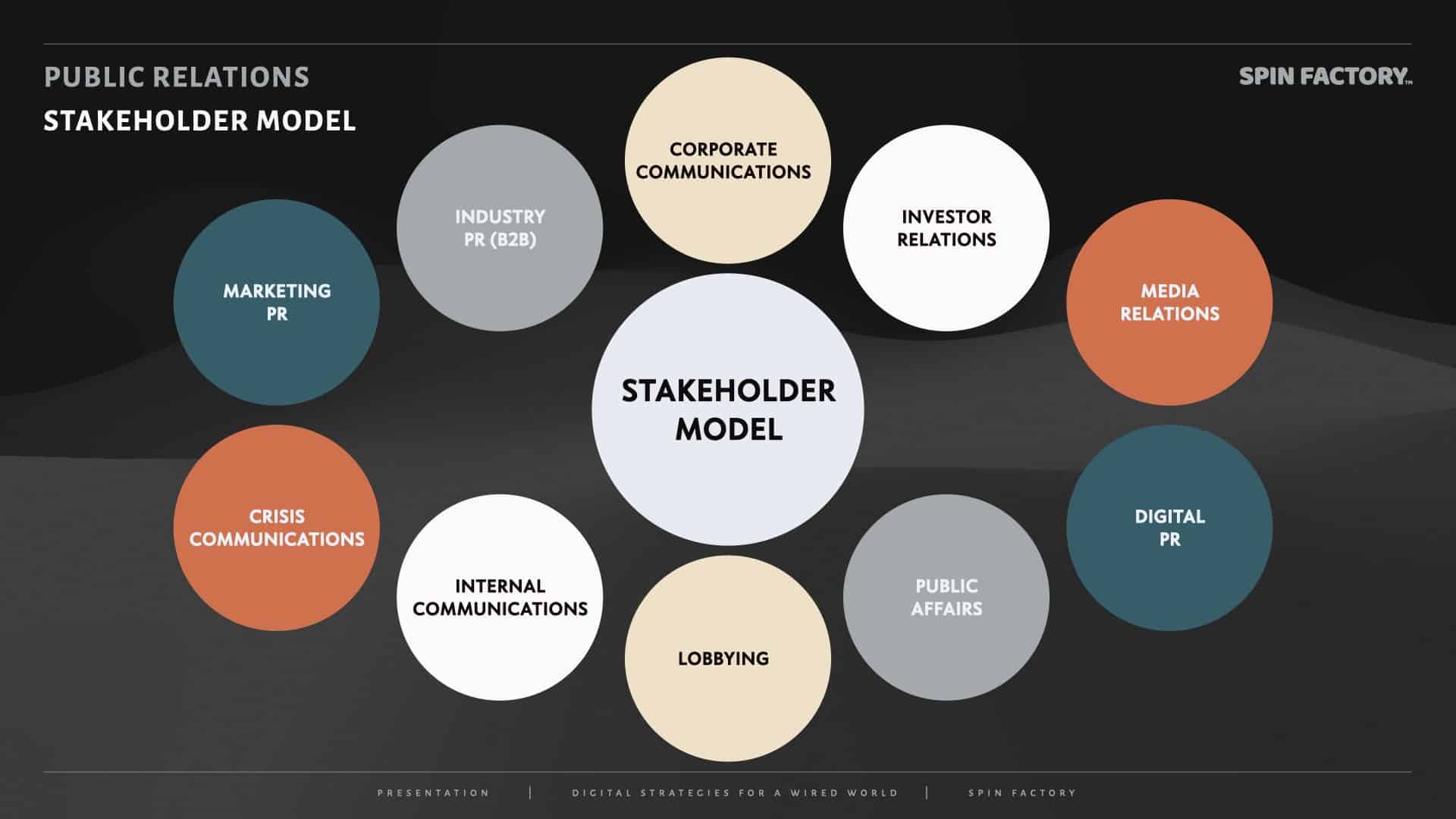
“In a corporation, a stakeholder is a member of ‘groups without whose support the organisation would cease to exist’, as defined in the first usage of the word in a 1963 internal memorandum at the Stanford Research Institute. The theory was later developed and championed by R. Edward Freeman in the 1980s. Since then it has gained wide acceptance in business practice and in theorising relating to strategic management, corporate governance, business purpose and corporate social responsibility (CSR).”
Source: Wikipedia 13Stakeholder (corporate). (2023, October 27). In Wikipedia. https://en.wikipedia.org/wiki/Stakeholder_(corporate)
PR Specialisations (Based on Stakeholders)
PR specialisations are typically named based on which stakeholder type they manage:
Corporate communications = an organisation’s strategic use of messaging to shape its reputation, articulate its vision, and engage with key audiences across internal and external channels.
Targets: External and internal publics, business journalists, regulatory institutions, partners, suppliers, vendors, etc.
Investor relations (IR) = an organisation’s deliberate communication efforts to build trust and maintain transparency with investors, analysts, and the financial community.
Targets: Shareholders, investors, market hubs, market analysts, financial institutions, trade journalists etc.
Media relations = a brand’s targeted use of communication to foster positive interactions with journalists, editors, and media outlets and to gain favourable coverage.
Targets: Journalists, editors, influencers, etc.
Digital PR = the strategic use of online communication to build brand communities, foster engagement, and manage reputation in the digital space. 14Silfwer, J. (2017, November 20). What is Digital PR? Doctor Spin | The PR Blog. https://doctorspin.net/what-is-digital-pr/
Targets: Inbound web traffic, brand communities, subscribers, fans, followers, influencers, social networks, etc.
Public affairs (PA) = a brand’s intentional use of communication to engage with governments, policymakers, and communities to influence public policy and social impact.
Targets: Voters, political journalists, political analysts, columnists, interest groups, etc.
Lobbying = the focused use of advocacy and communication to directly influence legislative and regulatory decisions in favour of specific interests or causes.
Targets: Politicians, legislators, government officials, committees, influencers, etc.
Internal communications (IC) = an organisation’s deliberate use of messaging to align, inform, and motivate employees while fostering a productive workplace culture.
Targets: Coworkers, potential recruits, etc.
Crisis communications = a brand’s rapid, strategic deployment of communication to mitigate reputational damage, address urgent challenges, and restore public trust during critical situations.
Targets: Crisis victims, worried publics, the general public, coworkers, journalists, influencers, customers, shareholders, etc.
Marketing PR = a brand’s tactical integration of communication and promotional efforts to enhance product awareness, drive sales, and support marketing objectives.
Targets: Potential customers, existing customers, trade journalists, members, affiliates, etc.
Industry PR (B2B) = a business’s purposeful use of communication to build credibility, foster trust, and establish thought leadership within its professional sector.
Targets: B2B clients, B2B prospects, trade journalists, trade organisations, niche influencers, etc.
Learn more: Stakeholders in Public Relations
The Influencers in Public Relations
In public relations, influencers are individuals who have managed to grow a substantial audience, which has the potential to affect a specific organisation either positively or negatively.
Influencers = independent content creators with influential platforms and followings of potential importance to a brand. 15Silfwer, J. (2020, January 15). The Influencers in Public Relations. Doctor Spin | The PR Blog. https://doctorspin.net/influencers-in-public-relations/
Establishing and maintaining good relationships with strategically chosen influencers for the organisation is often critically important.
“Influencers in public relations are emerging stakeholders who generate a state of opinion in the digital community that surpasses traditional public opinion.”
Source: The Role of Prosumers in the Interactive and Digital Processes of Public Relations 16Polo, M. (2020). The Role of Prosumers in the Interactive and Digital Processes of Public Relations. 161 – 174. https://doi.org/10.4018/978 – 1‑7998 – 3119‑8.ch012
How To Categorise Influencers
There aren’t standardised terminologies for influencer marketing and influencer relations, and no general following sizes or engagement ratios exist. However, it’s possible to make approximate distinctions.
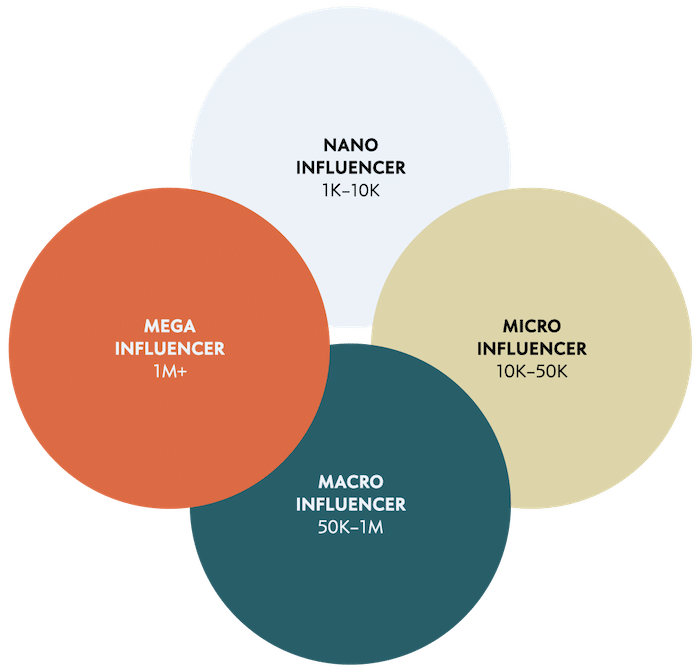
I recommend using the following tiers and naming conventions for categorising different types of influencers:
Learn more: The Influencers in Public Relations
What Public Relations Does
“Public relations budgets and resources are often less well-defined and less accepted than marketing budgets and resources, but both disciplines contribute to the bottom line.”
Source: Public Relations for Marketing Professionals 17Haywood, R. (1998). Public relations budget and resources. Public Relations for Marketing Professionals, 83 – 96. https://doi.org/10.1007/978 – 1‑349 – 14365-8_5
“Public relations and marketing both use relationship-building techniques, but their missions and philosophies are fundamentally different.”
Source: Public Relations Review 18Broom, G., Lauzen, M., & Tucker, K. (1991). Public relations and marketing: Dividing the conceptual domain and operational turf. Public Relations Review, 17, 219 – 225. … Continue reading
Public relations is fundamentally different from marketing. Let’s use the stakeholder model to understand better what PR professionals do.

Corporate Communications
(Sometimes used interchangeably with “Communications” and “Inhouse PR” as a general term.)
Corporate communications = an organisation’s strategic use of messaging to shape its reputation, articulate its vision, and engage with key audiences across internal and external channels.
Targets: External and internal publics, business journalists, regulatory institutions, partners, suppliers, vendors, etc.
What if an organisation depends not just on whether people buy its products or services but also on what people think of your organisation and how it conducts its business? What if people want to discuss critical topics with the organisation?
Unfortunately, promoting your products and services to these people won’t cut it. However, public relations has professional know-how in this area.
“Corporate communication is a new [editor’s note: published in 1996] and growing discipline that focuses on communication within organizations, relating to management, business, and organizational aspects.”
Source: Management Communication Quarterly 19Argenti, P. (1996). Corporate Communication as a Discipline. Management Communication Quarterly, 10, 73 — 97. https://doi.org/10.1177/0893318996010001005
Media Relations
(Sometimes referred to as “Press Office.”)
Media relations = a brand’s targeted use of communication to foster positive interactions with journalists, editors, and media outlets and to gain favourable coverage.
Targets: Journalists, editors, influencers, etc.
Some third-party publishers don’t accept payment because their livelihood depends on objectivity. Journalists (and influencers with journalistic ambitions) fall into this category. Their unbiased approach makes them highly influential.
For instance, you cannot send your ads to a journalist. They will refer you to their marketing department and ask you to pay!
However, a PR professional understands how to create material that a journalist (or an ambitious influencer) will want to feature to their audience.
“Organizations’ media relations activities can influence media content and opinions, but success depends on more than just distributing news releases.”
Source: Public Relations Review 20Turk, J. (1985). Information subsidies and influence. Public Relations Review, 11, 10 – 25. https://doi.org/10.1016/S0363-8111(85)80078 – 3
Investor Relations (IR)
Investor relations (IR) = an organisation’s deliberate communication efforts to build trust and maintain transparency with investors, analysts, and the financial community.
Targets: Shareholders, investors, market hubs, market analysts, financial institutions, trade journalists etc.
In some organisations, huge ones, there are various financial stakeholders: shareholders, investors, financial institutions, etc. You cannot “market” to these groups; their informational needs differ from those of potential consumers.
However, we understand how to engage in two-way communication within public relations.
“Investor relations officers significantly influence corporate disclosures and play a crucial role in private communication between IROs, analysts, and investors.”
Source: Journal of Accounting and Economics 21Brown, L., Call, A., Clement, M., & Sharp, N. (2019). Managing the narrative: Investor relations officers and corporate disclosure✰. Journal of Accounting and Economics. … Continue reading
Digital PR
(Sometimes referred to as “Digital Communications,” “Online PR,” or “Online Communications.”)
Digital PR = the strategic use of online communication to build brand communities, foster engagement, and manage reputation in the digital space. 22Silfwer, J. (2017, November 20). What is Digital PR? Doctor Spin | The PR Blog. https://doctorspin.net/what-is-digital-pr/
Targets: Inbound web traffic, brand communities, subscribers, fans, followers, influencers, social networks, etc.
Not all online traffic is paid for by ads. People search organically for information, knowledge, inspiration, entertainment, etc. Some people even wish to be more than just customers — they want to be fans, followers, and subscribers!
And yes, public relations is equipped to cater to the informational needs of financial stakeholders.
“Online public relations can enhance visibility and build relationships with the public, promoting organizations and products through dialogic communication.”
Source: Procedia — Social and Behavioral Sciences 23Petrovici, M. (2014). E‑Public Relations: Impact and Efficiency. A Case Study. Procedia — Social and Behavioral Sciences, 141, 79 – 84. https://doi.org/10.1016/J.SBSPRO.2014.05.015
Public Affairs (PA)
Public affairs (PA) = a brand’s intentional use of communication to engage with governments, policymakers, and communities to influence public policy and social impact.
Targets: Voters, political journalists, political analysts, columnists, interest groups, etc.
For some organisations, the general public’s opinion about specific issues matters. For an electric car manufacturer, what people think of society’s electrification matters because, in a democracy, public opinion will ultimately shape public policy.
In public relations, we have the skill set to navigate and manage public perceptions and shape opinions long-term. While advertising can support such endeavours, the driving force is usually public relations.
“Integrating corporate planning and public affairs perspectives is crucial for organizations to effectively respond to environmental change and adapt to social and political turbulence.”
Source: Long Range Planning 24Post, J., Murray, E., Dickie, R., & Mahon, J. (1982). The public affairs function in American corporations: Development and relations with corporate planning. Long Range Planning, 15, 12 – 21. … Continue reading
Lobbying
Lobbying = the focused use of advocacy and communication to directly influence legislative and regulatory decisions in favour of specific interests or causes.
Targets: Politicians, legislators, government officials, committees, influencers, etc.
At times, it’s a good idea to present your organisation’s ideas directly to those in charge of making the decisions, like politicians, legislators, analysts, topic experts, etc. And these groups are rarely convinced by marketing messages.
“Lobbying can be viewed as a form of legislative subsidy, providing policy information, political intelligence, and legislative labor to strategically selected legislators, assisting natural allies in achieving their objectives.”
Source: American Political Science Review 25Hall, R., & Deardorff, A. (2006). Lobbying as Legislative Subsidy. American Political Science Review, 100, 69 — 84. https://doi.org/10.1017/S0003055406062010
Internal Communications (IC)
Internal communications (IC) = an organisation’s deliberate use of messaging to align, inform, and motivate employees while fostering a productive workplace culture.
Targets: Coworkers, potential recruits, etc.
Most organisations have employees. Their opinions and attitudes towards the employer often decide whether the organisation will rise or fall. Aiming marketing campaigns at them rarely resolves any issues.
Public relations has a long and proud tradition of improving all types of communication within an organisation. (It’s also a major field of academic research!)
“Strengthening internal communication through various methods, including face-to-face communication, can improve employee engagement and build trust between management and employees.”
Source: International Journal of Business Communication 26Mishra, K., Boynton, L., & Mishra, A. (2014). Driving Employee Engagement. International Journal of Business Communication, 51, 183 — 202. https://doi.org/10.1177/2329488414525399
Crisis Communications
(Sometimes referred to as “Crisis Management.”)
Crisis communications = a brand’s rapid, strategic deployment of communication to mitigate reputational damage, address urgent challenges, and restore public trust during critical situations.
Targets: Crisis victims, worried publics, the general public, coworkers, journalists, influencers, customers, shareholders, etc.
Sometimes, things go wrong. In such situations, pausing all marketing campaigns is often a good idea. No one wants to see an ad for your business when people suffer or have gotten hurt.
We have developed a tried-and-tested toolbox in public relations to assist organisations in dealing with challenging scenarios.
“Effective crisis communication strategies, timing, and situational factors can guide managers in achieving desired outcomes and enhancing corporate reputation during crises.”
Source: Business Horizons 27Coombs, W. (2015). The value of communication during a crisis: Insights from strategic communication research. Business Horizons, 58, 141 – 148. https://doi.org/10.1016/J.BUSHOR.2014.10.003
Marketing PR
(Sometimes referred to as “Marketing Communications.”)
Marketing PR = a brand’s tactical integration of communication and promotional efforts to enhance product awareness, drive sales, and support marketing objectives.
Targets: Potential customers, existing customers, trade journalists, members, affiliates, etc.
Journalists and influencers are sometimes interested in consumer offerings, too. Potential customers are interested in learning about new products or services, and journalists might be curious, too. This often happens when there are big launches or significant technological advancements.
This is where marketing and public relations “cross swords.” While marketing uses paid campaigns to promote products or services, public relations pitches those products or services to journalists (and influencers with journalistic ambitions).
“Integrating marketing communications across traditional and new media can improve the effectiveness and efficiency of marketing programs.”
Source: Journal of Marketing 28Batra, R., & Keller, K. (2016). Integrating Marketing Communications: New Findings, New Lessons, and New Ideas. Journal of Marketing, 80, 122 — 145. https://doi.org/10.1509/jm.15.0419
Industry PR (B2B)
(Sometimes referred to as “B2B PR,” “B2B Communications,” or with more specificity, like “Tech PR,” “Telecom PR”, “Medical PR,” etc.)
Industry PR (B2B) = a business’s purposeful use of communication to build credibility, foster trust, and establish thought leadership within its professional sector.
Targets: B2B clients, B2B prospects, trade journalists, trade organisations, niche influencers, etc.
In many industries, organisations sell products and services to other companies. Marketing can be crucial, especially if there are thousands of potential customers. However, many niches are small and dependent on personal relationships.
Many organisations also depend on functional relationships with vendors, distributors, partners, suppliers, etc. Public relations is the way to communicate with these organisations.
“Contemporary public relations for B2B involves 7 distinct types of framing: situations, attributes, choices, actions, issues, responsibility, and news.”
Source: Journal of Public Relations Research 29Hallahan, K. (1999). Seven Models of Framing: Implications for Public Relations. Journal of Public Relations Research, 11, 205 – 242. https://doi.org/10.1207/S1532754XJPRR1103_02
Learn more: What Public Relations Does
Public Relations Objectives
“Public relations is a young academic field with potential to inform various areas of communication and offer tools like issues management for various applied communication fields.“
Source: Journal of Communication 30Botan, C., & Taylor, M. (2004). Public relations: State of the field. Journal of Communication, 54, 645 – 661. https://doi.org/10.1111/J.1460 – 2466.2004.TB02649.X
Building trust and credibility is a crucial objective of public relations. In an era where consumers are increasingly sceptical of advertising and corporate speak, PR offers a more authentic and credible way to communicate with the public.
But what exactly are PR professionals focused on achieving?
Categorised by the stakeholder model, here are examples of common public relations objectives:
Corporate Communications Objectives
The primary objective of corporate communications is to strategically manage and convey an organisation’s messages to internal and external stakeholders, publics, and influencers while fostering a consistent brand image, trust, engagement, and alignment with business goals.
Corporate communications = an organisation’s strategic use of messaging to shape its reputation, articulate its vision, and engage with key audiences across internal and external channels.
Targets: External and internal publics, business journalists, regulatory institutions, partners, suppliers, vendors, etc.
Examples of objectives:
Investor Relations Objectives
The primary objective of investor relations is to effectively communicate a company’s financial performance, strategy, and value proposition to current and potential investors, fostering trust, transparency, and support for the company’s long-term objectives.
Investor relations (IR) = an organisation’s deliberate communication efforts to build trust and maintain transparency with investors, analysts, and the financial community.
Targets: Shareholders, investors, market hubs, market analysts, financial institutions, trade journalists etc.
Examples of objectives:
Media Relations Objectives
The primary objective of media relations is to build and maintain positive relationships with influencers, journalists, and media outlets to ensure accurate, consistent, and favourable coverage of an organisation’s messages, initiatives, and reputation.
Media relations = a brand’s targeted use of communication to foster positive interactions with journalists, editors, and media outlets and to gain favourable coverage.
Targets: Journalists, editors, influencers, etc.
Examples of objectives:
Digital PR Objectives
The primary objective of digital PR is to enhance an organisation’s online presence and reputation by leveraging digital platforms, creating shareable content, and securing high-quality inbound traffic to drive visibility, engagement, and authority.
Digital PR = the strategic use of online communication to build brand communities, foster engagement, and manage reputation in the digital space. 31Silfwer, J. (2017, November 20). What is Digital PR? Doctor Spin | The PR Blog. https://doctorspin.net/what-is-digital-pr/
Targets: Inbound web traffic, brand communities, subscribers, fans, followers, influencers, social networks, etc.
Examples of objectives:
Public Affairs Objectives
The primary objective of public affairs is to influence public policy, legislation, and societal attitudes through strategic communication and advocacy to foster mutually beneficial relationships between organisations and governmental or regulatory stakeholders.
Public affairs (PA) = a brand’s intentional use of communication to engage with governments, policymakers, and communities to influence public policy and social impact.
Targets: Voters, political journalists, political analysts, columnists, interest groups, etc.
Examples of objectives:
Lobbying Objectives
The primary objective of lobbying is to influence decision-makers, particularly legislators and government officials, to support specific policies, regulations, or actions that align with an organisation’s or advocacy group’s interests.
Lobbying = the focused use of advocacy and communication to directly influence legislative and regulatory decisions in favour of specific interests or causes.
Targets: Politicians, legislators, government officials, committees, influencers, etc.
Examples of objectives:
Internal Communications Objectives
The primary objective of internal communications is to engage, inform, and align employees with the organisation’s goals, culture, and strategies, fostering collaboration, motivation, and a sense of shared purpose.
Internal communications (IC) = an organisation’s deliberate use of messaging to align, inform, and motivate employees while fostering a productive workplace culture.
Targets: Coworkers, potential recruits, etc.
Examples of objectives:
Crisis Communications Objectives
The primary objective of crisis communications is to protect and restore an organisation’s reputation, trust, and stability by managing the flow of accurate, timely, and strategic information during and after a crisis.
Crisis communications = a brand’s rapid, strategic deployment of communication to mitigate reputational damage, address urgent challenges, and restore public trust during critical situations.
Targets: Crisis victims, worried publics, the general public, coworkers, journalists, influencers, customers, shareholders, etc.
Examples of objectives:
Marketing PR Objectives
The primary objective of marketing PR is to generate awareness, interest, and demand for products or services by leveraging earned/shared/owned media, storytelling, and influencer engagement to complement marketing efforts and enhance brand credibility.
Marketing PR = a brand’s tactical integration of communication and promotional efforts to enhance product awareness, drive sales, and support marketing objectives.
Targets: Potential customers, existing customers, trade journalists, members, affiliates, etc.
Examples of objectives:
Industry PR Objectives
The primary objective of industry PR (B2B) is to build credibility, foster trust, and enhance thought leadership within a specific industry by communicating value, expertise, and innovations to business publics, niche influencers, and stakeholders.
Industry PR (B2B) = a business’s purposeful use of communication to build credibility, foster trust, and establish thought leadership within its professional sector.
Targets: B2B clients, B2B prospects, trade journalists, trade organisations, niche influencers, etc.
Examples of objectives:
Learn more: Public Relations Objectives
Approaches To Public Relations
There are three scholarly approaches to public relations (PR):
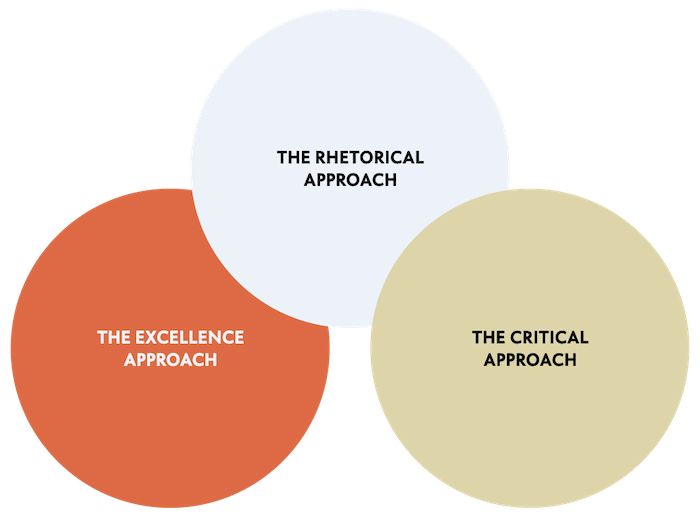
The excellence PR approach = this public relations approach focuses on objectives and corporate value creation. The underlying motivation behind the theory was that public relations were mainly a variety of tactical tools that desperately needed a management theory to work well in a sophisticated organisation. 32Silfwer, J. (2022, November 6). PR Approaches: Excellence, Rhetorical, and Critical. Doctor Spin | The PR Blog. https://doctorspin.net/pr-approaches/
Notable mentions: James E. Grunig, Larissa A. Grunig
The rhetorical PR approach = this public relations approach stems from ideas dating back to ancient Greece. It’s a psychological theory of how communication structures human culture by shaping human minds. The rhetorical approach is practical and lacks moral judgment. 33Silfwer, J. (2022, November 6). PR Approaches: Excellence, Rhetorical, and Critical. Doctor Spin | The PR Blog. https://doctorspin.net/pr-approaches/
Notable mentions: Edward Bernays, The Toronto School of Communication Theory, Robert Heath
The critical PR approach = this public relations approach is deeply rooted in theories of societal power dynamics. Power is seen as a means of exerting dominance, manipulation, and oppression. The critical approach borrows many ideas from the rhetorical approach by placing them in moral frameworks. 34Silfwer, J. (2022, November 6). PR Approaches: Excellence, Rhetorical, and Critical. Doctor Spin | The PR Blog. https://doctorspin.net/pr-approaches/
Notable mentions: Walter Lippmann, Noam Chomsky
The Excellence Approach to PR
Management theory often focuses on operational excellence. The Excellence Study mapped value creation onto strategic communication and found that best practices create value for an organisation. They reduce costs and risks while increasing revenue.
“The programme of research known as the excellence theory began in the 1960s with J. Grunig’s research on publics found among Colombian farmers. Research then followed on the role of public relations in organisational decision-making, the symmetrical model of public relations, public relations measurement, and how the structure and environment of organisations shape public relations behaviour. […] The excellence theory has evolved into a general theory of public relations as a strategic management function, and ongoing research now is adding concepts and tools that public relations professionals who serve in a strategic role can use.”
Source: Excellence Theory in Public Relations: Past, Present, and Future 35Grunig, J.E., & Grunig, L.A. (2008). Excellence Theory in Public Relations: Past, Present, and Future. https://www.semanticscholar.org/paper/ccfadd878d41454375357ce99ec7fcb148e6b48f
How can PR have such best practices? The answers are, non-surprisingly, management-focused: Leadership roles, goal alignments, high levels of strategic competency, high ethical standards, and two-way symmetric communication with corporate stakeholders.
Who typically prefers the excellence approach?
The Rhetorical Approach to PR
In ancient Greek society, public debate and persuasion were considered the best approaches to ensuring peaceful and stable governance. This was the cradle of ideas like democracy and free speech. There was no best practice, only outcomes from multiple voices.
“Rhetorical theory features how the public relations process becomes enriched through the role co-created, shared meaning plays in society as a blend of mind and self. The rhetorical heritage features the potent role of fact (as interpreted information), judgment, and identification as discourse themes enacted in public arenas. Public relations can add value to society by assuring that choices become enlightened, risks are ethically managed, and relationships are mutually developed. Through ethical rhetorical practice that results from the reflective character of organisations, public relations helps society to be more fully functioning.”
Source: Rhetorical Perspective and Public Relations: Meaning Matters 36Heath, R. L., & Frandsen, F. (2008). Rhetorical Perspective and Public Relations: Meaning Matters. VS Verlag Für Sozialwissenschaften EBooks, 349 – 364. … Continue reading
If you hear a PR professional talk passionately and positively about the importance of persuasion and perception management, they are most likely supporters of the rhetorical approach. They’re focused on language and relationships and think of society descriptively.
Many modern rhetorical concepts have stemmed from the Toronto School of Communication Theory and were later refined and further developed by Robert L. Heath.
Who typically prefers the rhetorical approach?
The Critical Approach to PR
“Critical theory” is a broad term encapsulating tools for analysis from various fields. Examples of such devices for analysis are feminism, cultural studies, structuralism, semiotics, and postmodernism. As a broad approach, it offers a wide range of scholarly criticism.
“The dominance of Excellence Theory in public relations theory and research may be eroding as contemporary issues in corporations, including the concern with activist challenges to reputation management and corporate social responsibility, increase in visibility and demand explanation. […] Excellence Theory’s acknowledgement of once-vilified concepts like persuasion and power sets the stage for critical public relations theory and research to emerge as significantly more capable of addressing activist advocacy and concomitant issues. The paper argues that critical theory, buoyed by acceptance of its key concepts, its increasing access to presentation venues and journals sympathetic to once-marginalised, alternative perspectives, is poised to infiltrate the public relations orthodoxy.”
Source: Public Relations Review 37Coombs, W. T., & Holladay, S. J. (2012). Fringe public relations: How activism moves critical pr toward the mainstream. Public Relations Review, 38(5), 880 – 887. … Continue reading
Since critical PR theory borrows from various scholarly traditions, it’s challenging to summarise the critical approach. But there’s often a focus on societal power dynamics and detailed victimology. The critical approach has many touch points with the rhetorical approach, but they tend to end up on opposite sides of the excellence approach:
While the rhetorical approach finds the excellence approach too normative, the critical approach isn’t normative enough.
Who typically prefers the rhetorical approach?
Read also: 3 PR Approaches: Excellence, Rhetorical, and Critical
The Four Models of Public Relations
In the Excellence study, James Grunig and Todd Hunt (1984) developed the most widely cited PR model in academic circles.
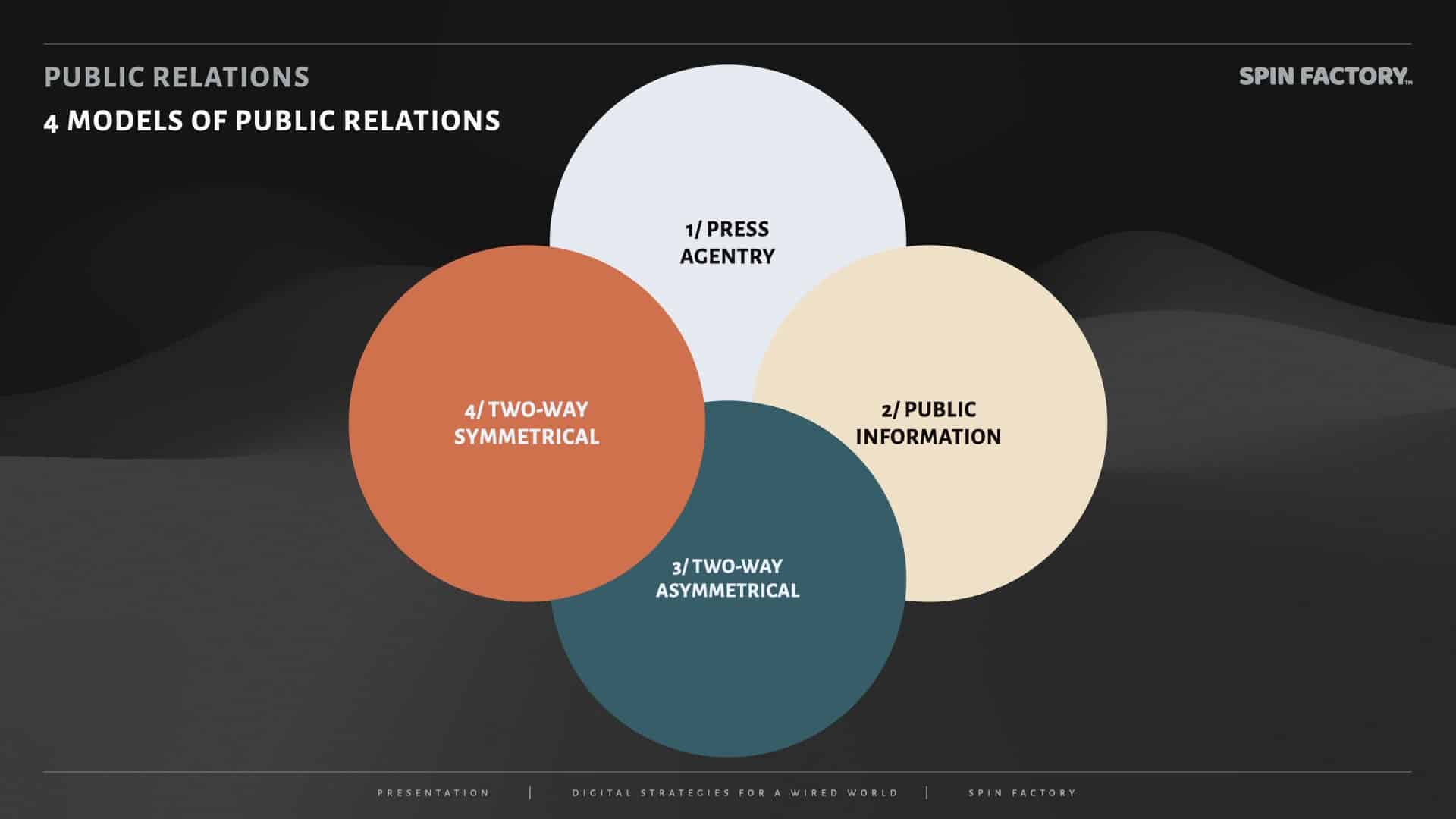
It’s not one model but four in sequence.
Grunig and Hunt’s four models of public relations provide valuable insights into the evolution of communication strategies and their implications for modern businesses.
The four models of public relations as a framework can be considered a cornerstone of the Excellence Approach. 38Silfwer, J. (2022, November 6). 3 PR Approaches: Excellence, Rhetorical, and Critical. Doctor Spin | The PR Blog. https://doctorspin.net/pr-approaches/
The excellence PR approach = this public relations approach focuses on objectives and corporate value creation. The underlying motivation behind the theory was that public relations were mainly a variety of tactical tools that desperately needed a management theory to work well in a sophisticated organisation. 39Silfwer, J. (2022, November 6). PR Approaches: Excellence, Rhetorical, and Critical. Doctor Spin | The PR Blog. https://doctorspin.net/pr-approaches/
Notable mentions: James E. Grunig, Larissa A. Grunig
The result? The researchers concluded that the two-way symmetrical model is the most effective way to practice public relations.
“The study of relationships within public relations has become increasingly important, with the Grunigs identifying testable variables to measure the quality of organizational relationships.”
Source: Journal of Professional Communication 40Grunig, J. (2011). Public relations excellence 2010. Journal of Professional Communication, 1. https://doi.org/10.15173/JPC.V1I1.85
Learn more: The Four Models of Public Relations
Public Relations vs Journalism

PR professionals and journalists share many practical skill sets. Still, public relations and journalism are fundamentally different:
Public relations is the effort to subjectively advocate agendas on special interests’ behalf.
A fundamental critique against public relations is that advocacy is an affluent privilege that manipulates the truth.
Journalism is the effort to objectively report the news on the public interest’s behalf.
A fundamental critique against journalism is that objectivity is unrealistic and the public interest heterogeneous.
But even if both public relations and journalism fail to live up to their ideal states at all times, both practices play vital roles in upholding a balanced and stable democracy.
Learn more: Public Relations vs Journalism
How To Measure Public Relations
How do you measure public relations (PR)? I recommend measuring attitudes and behaviours using questionnaires, rating scales, interviews, reports (logs, journals, diaries, etc.), and observations.
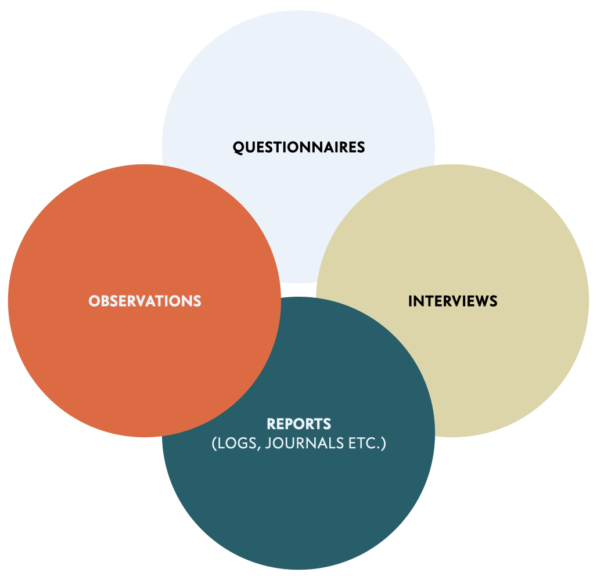
The general recommendation for PR measurement: I recommend the sociological method for getting valuable and actionable results from measuring public relations. This means measuring attitudes and behaviours. 41Silfwer, J. (2021, March 4). Methods of Measuring Public Relations. Doctor Spin | The PR Blog. https://doctorspin.net/measuring-public-relations/
Attitude Measurements in PR
There are a few things to consider when measuring attitudes and behaviours correctly. 42Educational Communications and Technology. (2001, August 3). 34.5 Measuring Attitudes. The Handbook of Research for Educational Communications and Technology. … Continue reading
An attitude measurement should meet the following criteria:
There are four main types of attitude measurement approaches:
There are four main types of attitude measurement methods:
Learn more: How To Measure Public Relations
The PESO Model
I often use the PESO model to underscore the critical differences between marketing (paid media) and public relations (earned, shared, and owned media).
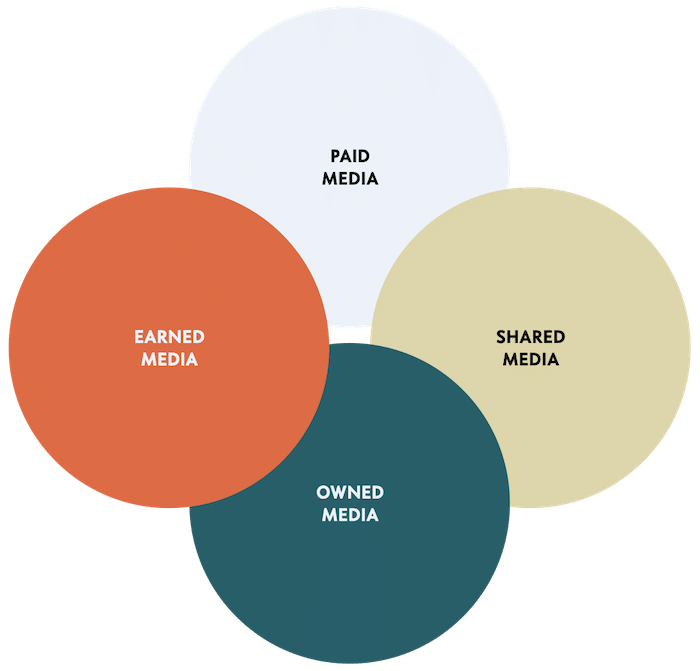
The PESO model divides the media landscape into four different media channel types:
Don Bartholomew, vice president of digital research at Fleishman Hillard, presented a version of the PESO model in 2010. According to PR blogger and PR measurement expert Heather Yaxley, his 2010 article is likely to be the earliest mention of the model:
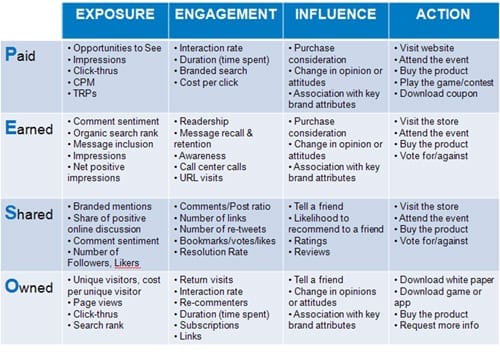
In 2013, PR blogger Gini Dietrich popularised the PESO model on her blog — and later trademarked! — her heavily promoted and widely spread infographic.
“In June 2013, Gini Dietrich presented the first iteration of the PESO model you may recognise in a blog post: The Four Different Types of Media. It was followed in August by the post Mobile Marketing: Use the Four Media Types in Promotion, where she talked about integrating paid, earned, owned, and shared.”
Source: PRConversations.com 43Yaxley, H. (2020, June 28). Tracing the measurement origins of PESO. PRConversations.com. https://www.prconversations.com/tracing-the-measurement-origins-of-peso/
“It is also worth pointing out this 2010 McKinsey Quarterly article by David Edelman and Britan Salsburg that includes sold and hijacked media alongside what used to be called POEM (paid, owned and earned media). Both of these concepts still have value even though their execution has changed in the past decade.“
Source: PRConversations.com 44Yaxley, H. (2020, June 28). Tracing the measurement origins of PESO. PRConversations.com. https://www.prconversations.com/tracing-the-measurement-origins-of-peso/
Learn more: The PESO Model: Paid, Earned, Shared, and Owned Media
The Father of PR: Edward Bernays
Edward Bernays (1891 – 1995) is considered the father of public relations (PR). His uncle was the famous psychologist Sigmund Freud, and Bernays, too, was interested in behavioural psychology. 45Edward Bernays. (2023, November 13). In Wikipedia. https://en.wikipedia.org/wiki/Edward_Bernays 46Olasky, M. (1984). Retrospective: Bernays’ doctrine of public opinion. Public Relations Review, 10, 3 – 12. https://doi.org/10.1016/S0363-8111(84)80088 – 0
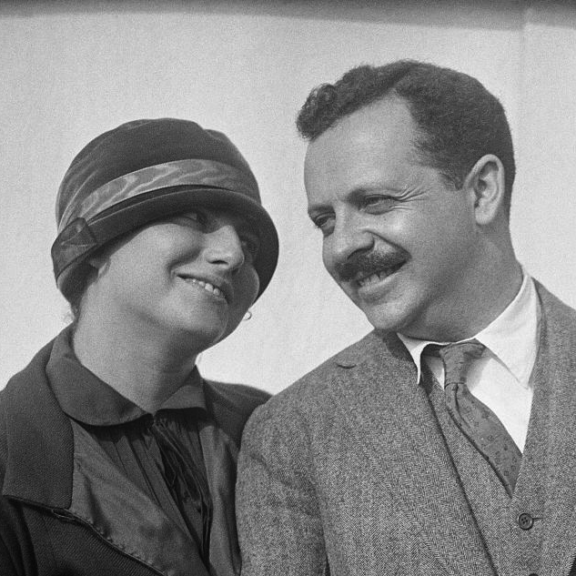
Edward Bernays’ wife, Doris Fleischmann, was also a PR consultant who significantly contributed to the PR industry.
Bernays certainly was something of a character: His most famous book is titled “Propaganda” — in which he outlined how to manage the perceptions of crowds, much like modern Niccolo Machiavelli or Sun Tzu. 47Propaganda. (2023, November 10). In Wikipedia. https://en.wikipedia.org/wiki/Propaganda_(book)
“The conscious and intelligent manipulation of the organised habits and opinions of the masses is an important element in democratic society. Those who manipulate this unseen mechanism of society constitute an invisible government which is the true ruling power of our country.”
Source: Propaganda 48Bernays, E. L. (1928). Propaganda. New York, NY: Horace Liveright.
PR Case Study: Torches of Freedom
When helping Lucky Strike, Bernays realised that cigarette smoking was mostly a male habit. From a business perspective, there was a golden opportunity to add half the population to Lucky Strike’s list of potential customers.
No one had done this successfully, not because no one ever had that idea, but because it was a tough nut to crack. But Edward Bernays succeeded by tapping into another prevailing trend in society: The emancipation of women.
Bernays positioned cigarettes for women as “Torches of Freedom.” He placed the idea in articles, newspapers, celebrity endorsements, and events. He planted the public perception of women smoking not because it was enjoyable but as a symbol of female independence.
PR Case Study: Eggs and Bacon
Have you ever had eggs and bacon for breakfast at a hotel? Well, you can thank Bernays for that idea.
Another PR legend is how Bernays helped the farming industry convince people to eat more eggs and bacon. To do this, he wanted to change people’s perceptions of when it’s okay to eat eggs and bacon.
Bernays cooperated with food scientists to establish that eggs and bacon should be part of a healthy breakfast for every American. And to manifest this, he collaborated with chains of hotels to have them serve eggs and bacon for breakfast. 49Later in life, Bernays became a vegetarian and advocated for a meatless diet, which was unusual at the time, especially given his work promoting products like bacon.
Learn more: Edward Bernays — The Father of PR
John Dewey and the ‘P’ in Public Relations
The term “publics” can be traced back to the work of the American psychologist and philosopher John Dewey (1859 – 1952). 50John Dewey. (2023, March 25). In Wikipedia. https://en.wikipedia.org/wiki/John_Dewey
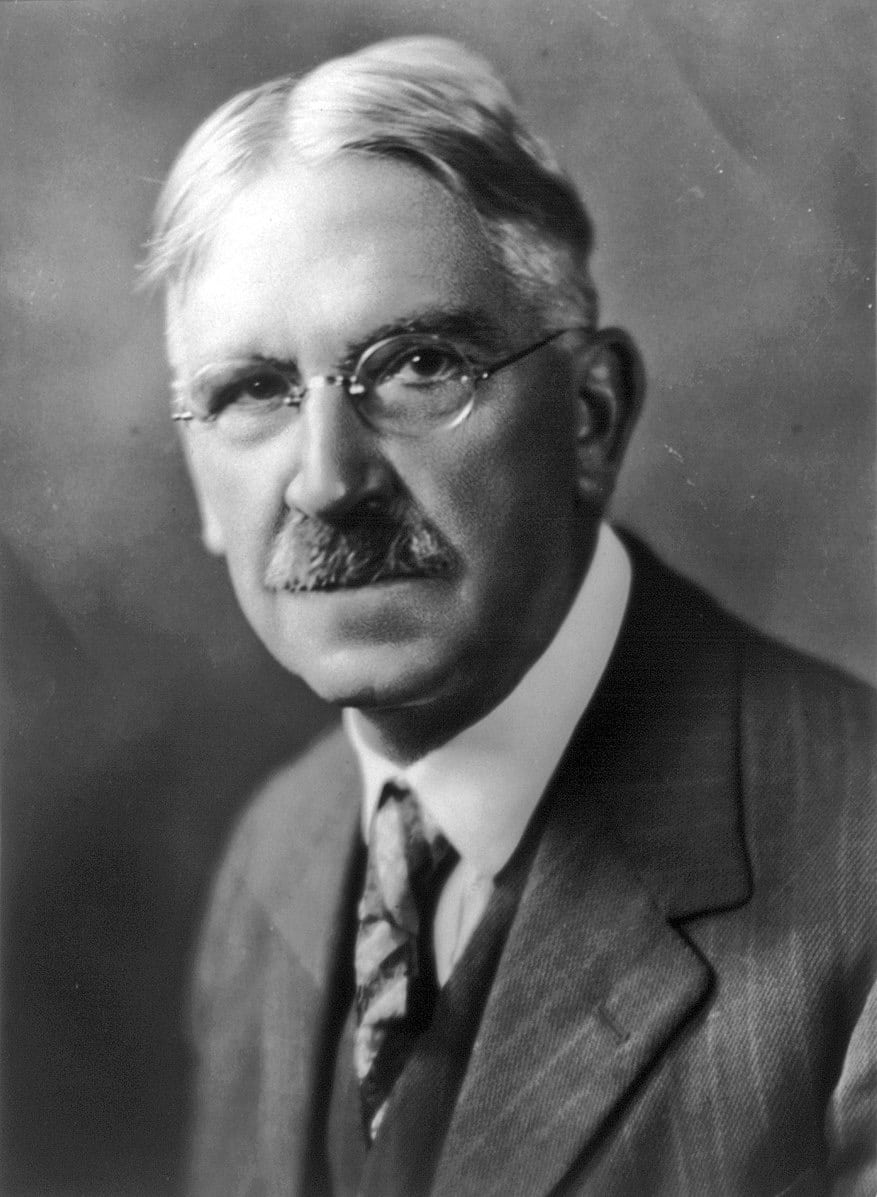
In his 1927 book, “The Public and Its Problems,” Dewey conceptualised publics as situational groups formed in response to shared concerns or issues. He posited that these groups emerge when individuals confront a common problem, recognise its existence, and take collective action to address it. 51Dewey, J. (1927). The Public and Its Problems. Athens, Ohio: Swallow Press.
“Dewey’s theory of the public sphere recognizes multiple publics and permeable borders between public and private, with communication playing a crucial role in public formation and re-formation.”
Source: Argumentation and Advocacy 52Asen, R. (2003). The Multiple Mr. Dewey: Multiple Publics and Permeable Borders in John Dewey’s Theory of the Public Sphere. Argumentation and Advocacy, 39, 174 — 188. … Continue reading
Dewey’s formulation of publics marked a significant departure from the traditional understanding of the “mass public,” which assumed a more homogeneous and passive audience.
By highlighting the situational and dynamic nature of publics, Dewey laid the foundation for a more nuanced and adaptive approach to understanding the complex interactions between organisations and their various audiences.
The term publics has become a cornerstone of modern public relations and communication theory.
This understanding of publics as situational and ever-changing highlighted the need for organisations to remain agile and adaptive in their communication efforts.
By recognising the diverse and situational nature of publics, PR professionals and communicators can better understand the needs and concerns of their various audiences, allowing them to develop more effective communication strategies.
“This recognition of the active and dynamic nature of publics has also influenced broader academic and public discourse, highlighting the importance of understanding and engaging with different groups of people who share common interests, concerns, or problems.”
Source: Contemporary Pragmatism 53Rogers, M. (2010). Introduction: Revisiting The Public and Its Problems. Contemporary Pragmatism, 7, 1 – 7. https://doi.org/10.1163/18758185 – 90000152
Learn more: John Dewey and the ‘P’ in Public Relations
Marshall McLuhan: “The Medium is the Message”
“The medium is the message” is a phrase coined by the Canadian philosopher Marshall McLuhan in the first chapter of his notable book “Understanding Media: The Extensions of Man.” 54Understanding Media. (2023, September 18). In Wikipedia. https://en.wikipedia.org/wiki/Understanding_Media
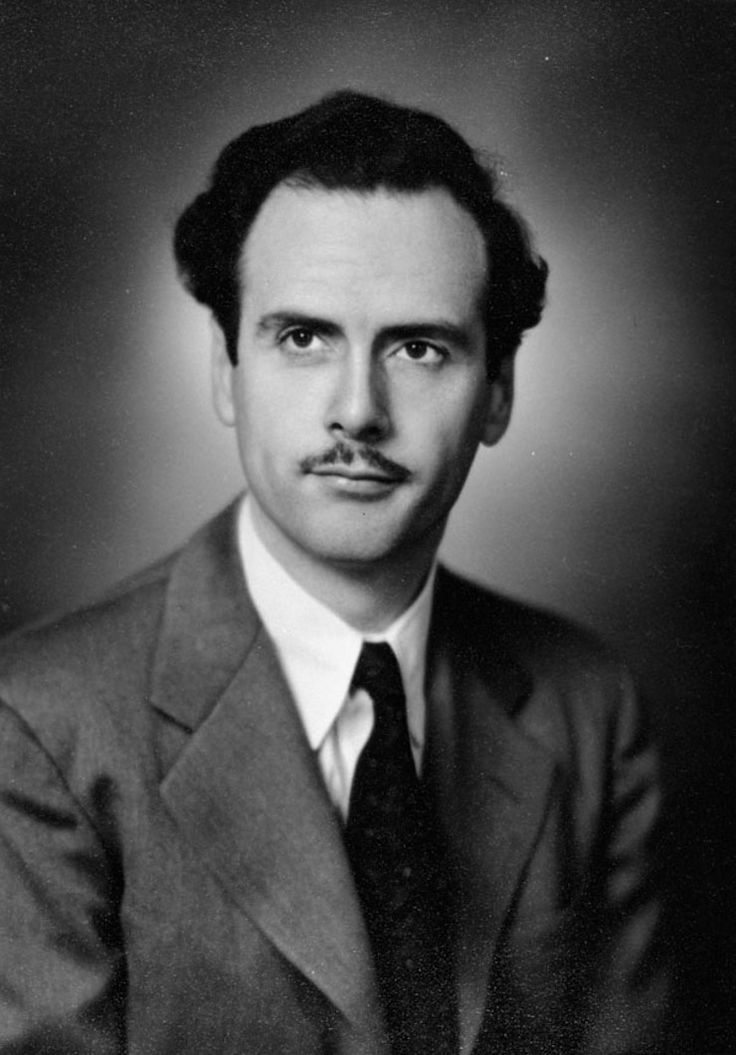
Despite being one of the most influential thinkers in media theory, McLuhan’s ideas are often widely misunderstood. “The medium is the message” is no exception.
“The medium is the message” doesn’t imply that content or substance lacks importance; it only implies that the medium in which messages are sent will significantly impact humanity.
McLuhan viewed human technologies as extensions of our human physiology. Our ability to build houses extends our human skin, as it protects against the elements. This added layer of protection and physical safety frees up mental bandwidth for human interaction.
In McLuhan’s interpretation, a house is a medium. All human technologies, down to the campfire, are considered mediums.
“McLuhan’s insight was that a medium affects the society in which it plays a role not by the content delivered over the medium, but by the characteristics of the medium itself. […] McLuhan pointed to the light bulb as a clear demonstration of this concept. A light bulb does not have content in the way that a newspaper has articles or a television has programs, yet it is a medium that has a social effect; that is, a light bulb enables people to create spaces during nighttime that would otherwise be enveloped by darkness.”
Source: Wikipedia 55Marshall McLuhan. (2023, May 15). In Wikipedia. https://en.wikipedia.org/wiki/Marshall_McLuhan
McLuhan argued that our ability to create technological extensions of our human abilities fundamentally impacts our society — far more than any single message conveyed via the new technology.
For example:
And so on.
Why is McLuhan’s analysis necessary?
“The medium is the message” is a stark reminder that a medium’s format (and limitations) will massively impact human society — and the messages themselves, too.
Holistically, a new technological medium will impact humanity significantly more than any single message transmitted through that medium. But Marshall McLuhan said it better, “The medium is the message.”
We often default to seeking meaning in messages but forget to consider the medium’s inherent media logic.
Learn more: Media Logic is Dead, Long Live Media Logic
Phineas Taylor Barnum: “There’s No Such Thing as Bad Publicity”
Phineas Taylor (P.T.) Barnum was a 19th-century American showman, entrepreneur, and politician known for his larger-than-life personality and uncanny ability to capture the public’s imagination. Born in 1810 in Bethel, Connecticut, Barnum rose to prominence in the entertainment world by founding the Barnum & Bailey Circus, dubbed “The Greatest Show on Earth.”
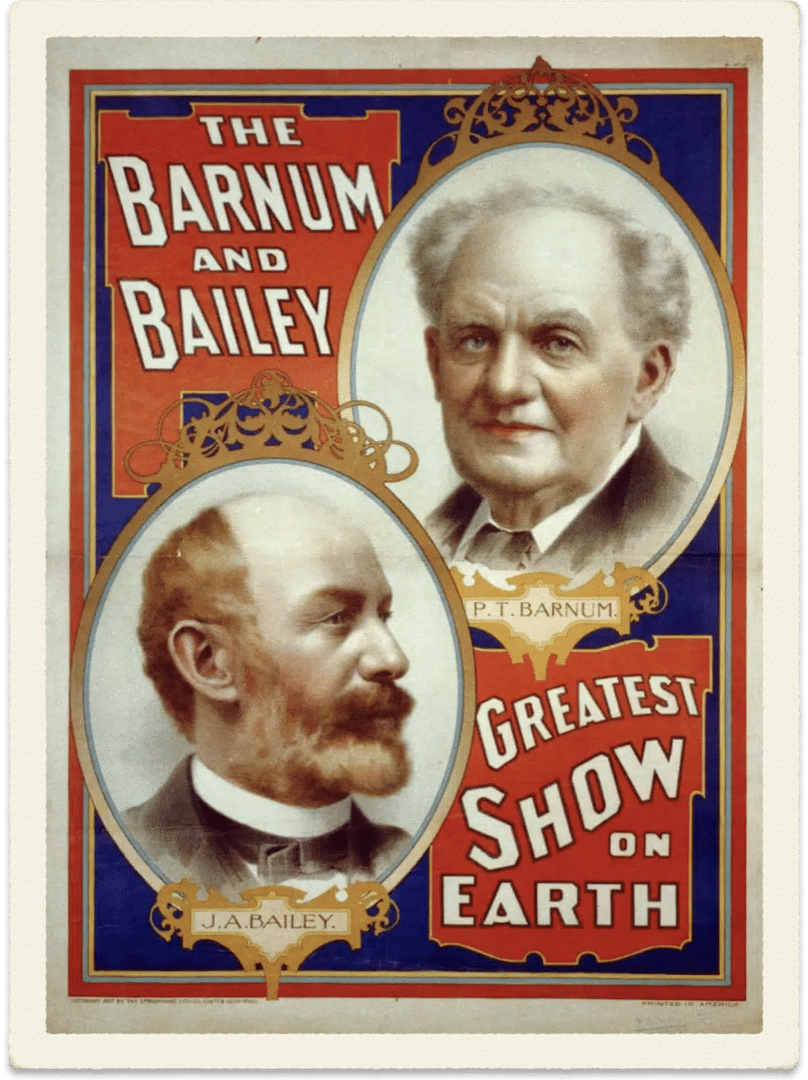
Barnum pioneered the art of the press agentry model, employing sensationalism and publicity stunts to generate interest and draw crowds to his shows. His innovative marketing techniques and relentless pursuit of the extraordinary laid the groundwork for many modern public relations strategies.
“Phineas Taylor (P.T.) Barnum (1810−1891) was a savvy publicity showman, one who impacted particular aspects of public relations and advertising, primarily event planning, event promotion and true publicity/media coverage. Ahead of others in his time, he actually understood the importance of media coverage (he started New York’s first illustrated newspaper in 1853) and believed ‘there is no such thing as bad publicity,’ a popular phrase many times attributed to Barnum himself.”
Source: Big Communications 56Foster, A. (2017, January 20). The End of a Publicity Era: How P.T Barnum Affected Marketing and PR. Big Communications. https://bigcom.com/2017/01/pt-barnum-marketing-and-public-relations/
Although some critics have labelled Barnum as a purveyor of hoaxes and deception, his enduring legacy as a visionary showman and master of spectacle continues to captivate audiences and inspire generations of entertainers and entrepreneurs.
An organisation, starved of attention, trust, and loyalty, is compelled to wage a perpetual struggle for its continued existence.
Learn more: P.T. Barnum: “There’s No Such Thing as Bad Publicity”
Walter Lippmann and Perception Management
In his seminal work Public Opinion (1922), Walter Lippmann laid the intellectual groundwork for the idea that perception and reality are not the same — a core principle of modern perception management. 57Lippmann, Walter. 1960. Public Opinion (1922). New York: Macmillan.
Lippmann argued that:
Lippmann’s ideas resonate deeply with perception management in public relations.
“We are all captives of the picture in our head — our belief that the world we have experienced is the world that really exists.”
— Walter Lippmann (1889 – 1974)
On Creating Pseudo-Environments
Lippmann coined the term “pseudo-environment,” which describes the filtered, biased, and often artificial version of reality presented by the media. He warned that influential elites could exploit this manufactured reality to manipulate public thought and behaviour.
Lippmann was sceptical about the public’s ability to discern reality from the pseudo-environment, which raises ethical concerns:
Perception management is not inherently sinister, but as Lippmann warned, it places immense power in the hands of those controlling the narrative.
In essence, perception management is the applied PR version of Lippmann’s media critique. It acknowledges that facts alone do not win public trust—priming, framing, storytelling, and emotional appeal do.
Learn more: Perception Management
PR Professionals in Popular Culture
Fictitious PR professionals have made a few notable appearances in popular culture.
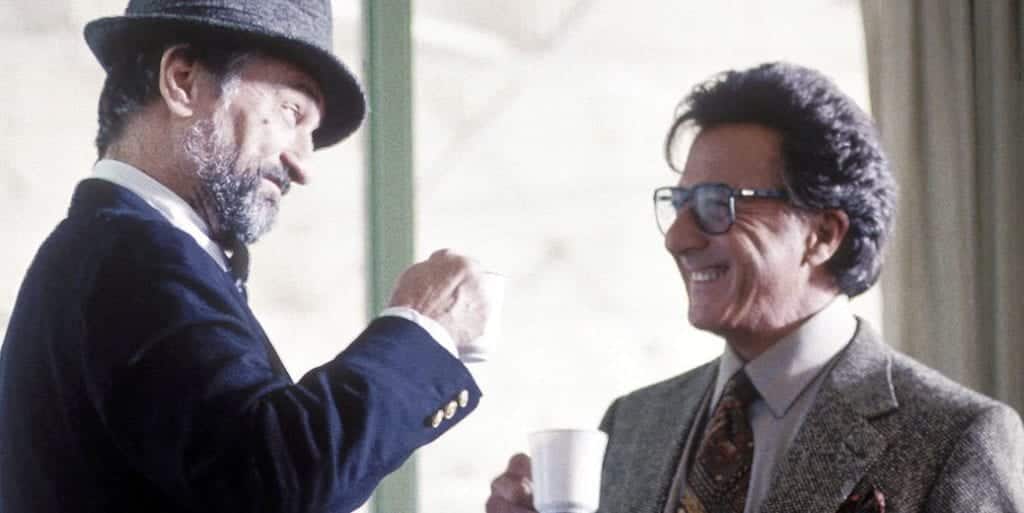
Here are a few unforgettable performances:
Learn more: 12 PR Movies Every Spin Doctor Should Watch
List of PR Blogs
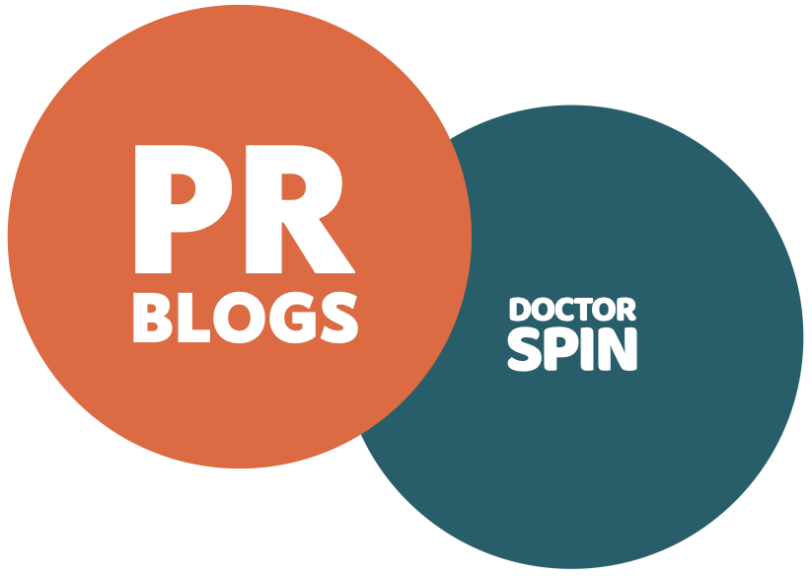
PR blogs come and go, and some seem to go on and on — I should know. I’ve been blogging before, during, and after it was considered cool. Today, I still find that having a great website is underrated.
Many organisations overestimate their social media presence and underestimate their online base camp — their website.
Blogging is still the cornerstone of content communications. To stay current, I update this list with active blogs on public relations and communications (2024).
Would you happen to know of an active PR blog that I should include in this list? Please let me know!
Learn more: Doctor Spin’s List of PR Blogs
PR Must Adapt — Or Die
Digital media will be the prime mover of people’s perceptions for a long time. It has become our number-one source for information, group formation, and dialogue.
The biggest challenge in modern public relations is the constantly changing media landscape. With the proliferation of social media, the rise of fake news, and the decline of traditional journalism, it can be difficult for organisations to control the spread of information and protect their reputations.
When Brian Solis and Deirdre Breakenridge published Putting the Public Back in Public Relations: How Social Media Is Reinventing the Aging Business of PR in 2009, it proposed how PR should embrace the digital-first media landscape and elevate our profession to new heights. 58Solis, B. & D. Breakenridge (2009, February 1). Putting the Public Back in Public Relations: How Social Media Is Reinventing the Aging Business of PR. Amazon.com: Books. … Continue reading
As we choose our future as public relations professionals, we must realise that the internet and its algorithms are more powerful than a few (barely surviving) newspapers.
The era of traditional print media is over:
Digital-first is no longer a matter of perspective — it’s a promise.
If we allow the world to think of PR professionals as outdated flacks, we’ll fade into oblivion while armies of digital marketers take over our responsibilities.
PR professionals must be strategic and proactive in their approach and able to adapt to new technologies and platforms to communicate effectively with their publics.
“The authors argue that earlier paradigms are mostly inadequate in addressing the needs of a 21st Century in which communication technology is creating rapid globalization while it is dangerously exacerbating the tensions of multiculturalism. Through a critical discussion of prior assumptions and paradigms in public relations scholarship, the authors underline the need for public relations to revitalize and bring its body of knowledge into the 21st Century.”
Source: Public Relations Review 59Valentini, C., Kruckeberg, D., & Starck, K. (2012). Public relations and community: A persistent covenant. Public Relations Review, 38(5), 873 – 879. https://doi.org/10.1016/j.pubrev.2012.06.001
The biggest challenge in PR is ensuring that our profession keeps up with new communication technology and stays valuable and relevant as a business function.
So, what does this mean?
It means that digital communication is not a fad.
It means that we must adapt — or perish.
Learn more: PR Must Adapt (Or Die)

THANKS FOR READING.
Need PR help? Hire me here.

What should you study next?
Spin Academy | Online PR Courses
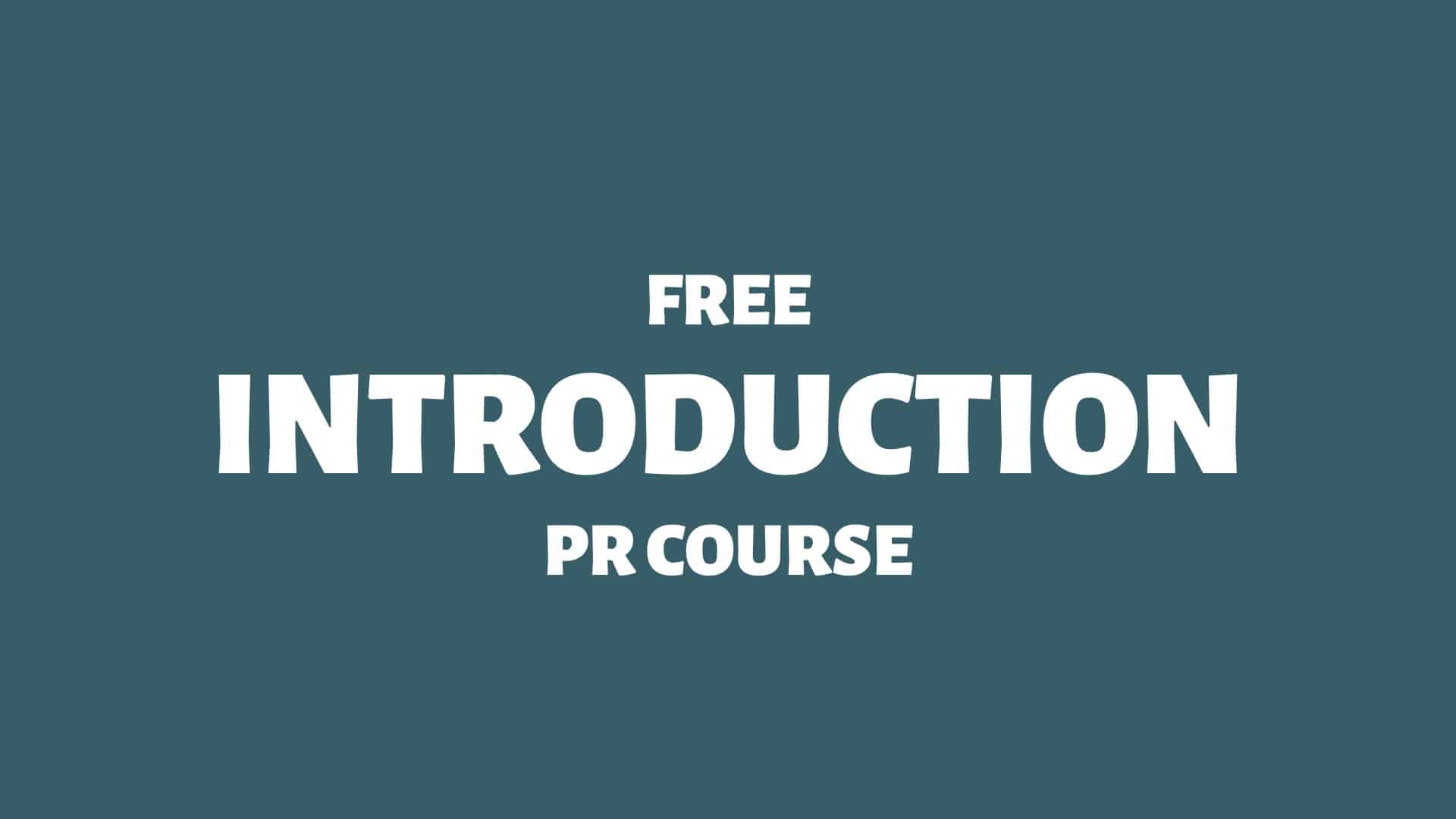
Spin’s PR School: Free Introduction PR Course
Get started with this free Introduction PR Course and learn essential public relations skills and concepts for future success in the PR industry.
Introducing Public Relations
Public Relations History
Publics in Public Relations
Comparing Public Relations
Public Relations Resources
Learn more: All Free PR Courses
💡 Subscribe and get a free ebook on how to get better PR.

Annotations
| 1 | From the early 1900s to 1976, Rex F. Harlow, a well-respected expert on public relations, gathered around 500 different definitions of public relations (Cutlip et al. 2006). |
|---|---|
| 2 | Morris, T., & Goldsworthy, S. (2008). From PR to propaganda. 97 – 111. https://doi.org/10.1007/978 – 0‑230 – 59485-2_7 |
| 3 | Silfwer, J. (2015, November 7). What is Public Relations? Doctor Spin | The PR Blog. https://doctorspin.net/what-is-public-relations/ |
| 4, 7 | Silfwer, J. (2015, June 11). The Publics in Public Relations. Doctor Spin | The PR Blog. https://doctorspin.net/publics-in-public-relations/ |
| 5, 11 | Silfwer, J. (2021, January 5). The Stakeholders in Public Relations. Doctor Spin | The PR Blog. https://doctorspin.net/stakeholders-in-public-relations/ |
| 6, 15 | Silfwer, J. (2020, January 15). The Influencers in Public Relations. Doctor Spin | The PR Blog. https://doctorspin.net/influencers-in-public-relations/ |
| 8, 9 | Hallahan, K. (2000). Inactive publics: The forgotten publics in public relations. Public Relations Review, 26(4), 499 – 515. https://doi.org/10.1016/S0363-8111(00)00061 – 8 |
| 10 | Hallahan, K. (2009, November 19). The Dynamics of Issues Activation and Response: An Issues Processes Model. Journal of Public Relations Research. https://www.tandfonline.com/doi/abs/10.1207/S1532754XJPRR1301_3 |
| 12 | Smith, B. (2012). Public relations identity and the stakeholder – organization relationship: A revised theoretical position for public relations scholarship. Public Relations Review, 38, 838 – 845. https://doi.org/10.1016/J.PUBREV.2012.06.011 |
| 13 | Stakeholder (corporate). (2023, October 27). In Wikipedia. https://en.wikipedia.org/wiki/Stakeholder_(corporate) |
| 14, 22, 31 | Silfwer, J. (2017, November 20). What is Digital PR? Doctor Spin | The PR Blog. https://doctorspin.net/what-is-digital-pr/ |
| 16 | Polo, M. (2020). The Role of Prosumers in the Interactive and Digital Processes of Public Relations. 161 – 174. https://doi.org/10.4018/978 – 1‑7998 – 3119‑8.ch012 |
| 17 | Haywood, R. (1998). Public relations budget and resources. Public Relations for Marketing Professionals, 83 – 96. https://doi.org/10.1007/978 – 1‑349 – 14365-8_5 |
| 18 | Broom, G., Lauzen, M., & Tucker, K. (1991). Public relations and marketing: Dividing the conceptual domain and operational turf. Public Relations Review, 17, 219 – 225. https://doi.org/10.1016/0363 – 8111(91)90018‑G |
| 19 | Argenti, P. (1996). Corporate Communication as a Discipline. Management Communication Quarterly, 10, 73 — 97. https://doi.org/10.1177/0893318996010001005 |
| 20 | Turk, J. (1985). Information subsidies and influence. Public Relations Review, 11, 10 – 25. https://doi.org/10.1016/S0363-8111(85)80078 – 3 |
| 21 | Brown, L., Call, A., Clement, M., & Sharp, N. (2019). Managing the narrative: Investor relations officers and corporate disclosure✰. Journal of Accounting and Economics. https://doi.org/10.1016/J.JACCECO.2018.08.014 |
| 23 | Petrovici, M. (2014). E‑Public Relations: Impact and Efficiency. A Case Study. Procedia — Social and Behavioral Sciences, 141, 79 – 84. https://doi.org/10.1016/J.SBSPRO.2014.05.015 |
| 24 | Post, J., Murray, E., Dickie, R., & Mahon, J. (1982). The public affairs function in American corporations: Development and relations with corporate planning. Long Range Planning, 15, 12 – 21. https://doi.org/10.1016/0024 – 6301(82)90115 – 7 |
| 25 | Hall, R., & Deardorff, A. (2006). Lobbying as Legislative Subsidy. American Political Science Review, 100, 69 — 84. https://doi.org/10.1017/S0003055406062010 |
| 26 | Mishra, K., Boynton, L., & Mishra, A. (2014). Driving Employee Engagement. International Journal of Business Communication, 51, 183 — 202. https://doi.org/10.1177/2329488414525399 |
| 27 | Coombs, W. (2015). The value of communication during a crisis: Insights from strategic communication research. Business Horizons, 58, 141 – 148. https://doi.org/10.1016/J.BUSHOR.2014.10.003 |
| 28 | Batra, R., & Keller, K. (2016). Integrating Marketing Communications: New Findings, New Lessons, and New Ideas. Journal of Marketing, 80, 122 — 145. https://doi.org/10.1509/jm.15.0419 |
| 29 | Hallahan, K. (1999). Seven Models of Framing: Implications for Public Relations. Journal of Public Relations Research, 11, 205 – 242. https://doi.org/10.1207/S1532754XJPRR1103_02 |
| 30 | Botan, C., & Taylor, M. (2004). Public relations: State of the field. Journal of Communication, 54, 645 – 661. https://doi.org/10.1111/J.1460 – 2466.2004.TB02649.X |
| 32, 33, 34, 39 | Silfwer, J. (2022, November 6). PR Approaches: Excellence, Rhetorical, and Critical. Doctor Spin | The PR Blog. https://doctorspin.net/pr-approaches/ |
| 35 | Grunig, J.E., & Grunig, L.A. (2008). Excellence Theory in Public Relations: Past, Present, and Future. https://www.semanticscholar.org/paper/ccfadd878d41454375357ce99ec7fcb148e6b48f |
| 36 | Heath, R. L., & Frandsen, F. (2008). Rhetorical Perspective and Public Relations: Meaning Matters. VS Verlag Für Sozialwissenschaften EBooks, 349 – 364. https://doi.org/10.1007/978 – 3‑531 – 90918-9_23 |
| 37 | Coombs, W. T., & Holladay, S. J. (2012). Fringe public relations: How activism moves critical pr toward the mainstream. Public Relations Review, 38(5), 880 – 887. https://doi.org/10.1016/j.pubrev.2012.02.008 |
| 38 | Silfwer, J. (2022, November 6). 3 PR Approaches: Excellence, Rhetorical, and Critical. Doctor Spin | The PR Blog. https://doctorspin.net/pr-approaches/ |
| 40 | Grunig, J. (2011). Public relations excellence 2010. Journal of Professional Communication, 1. https://doi.org/10.15173/JPC.V1I1.85 |
| 41 | Silfwer, J. (2021, March 4). Methods of Measuring Public Relations. Doctor Spin | The PR Blog. https://doctorspin.net/measuring-public-relations/ |
| 42 | Educational Communications and Technology. (2001, August 3). 34.5 Measuring Attitudes. The Handbook of Research for Educational Communications and Technology. https://members.aect.org/edtech/ed1/34/34 – 05.html |
| 43, 44 | Yaxley, H. (2020, June 28). Tracing the measurement origins of PESO. PRConversations.com. https://www.prconversations.com/tracing-the-measurement-origins-of-peso/ |
| 45 | Edward Bernays. (2023, November 13). In Wikipedia. https://en.wikipedia.org/wiki/Edward_Bernays |
| 46 | Olasky, M. (1984). Retrospective: Bernays’ doctrine of public opinion. Public Relations Review, 10, 3 – 12. https://doi.org/10.1016/S0363-8111(84)80088 – 0 |
| 47 | Propaganda. (2023, November 10). In Wikipedia. https://en.wikipedia.org/wiki/Propaganda_(book) |
| 48 | Bernays, E. L. (1928). Propaganda. New York, NY: Horace Liveright. |
| 49 | Later in life, Bernays became a vegetarian and advocated for a meatless diet, which was unusual at the time, especially given his work promoting products like bacon. |
| 50 | John Dewey. (2023, March 25). In Wikipedia. https://en.wikipedia.org/wiki/John_Dewey |
| 51 | Dewey, J. (1927). The Public and Its Problems. Athens, Ohio: Swallow Press. |
| 52 | Asen, R. (2003). The Multiple Mr. Dewey: Multiple Publics and Permeable Borders in John Dewey’s Theory of the Public Sphere. Argumentation and Advocacy, 39, 174 — 188. https://doi.org/10.1080/00028533.2003.11821585 |
| 53 | Rogers, M. (2010). Introduction: Revisiting The Public and Its Problems. Contemporary Pragmatism, 7, 1 – 7. https://doi.org/10.1163/18758185 – 90000152 |
| 54 | Understanding Media. (2023, September 18). In Wikipedia. https://en.wikipedia.org/wiki/Understanding_Media |
| 55 | Marshall McLuhan. (2023, May 15). In Wikipedia. https://en.wikipedia.org/wiki/Marshall_McLuhan |
| 56 | Foster, A. (2017, January 20). The End of a Publicity Era: How P.T Barnum Affected Marketing and PR. Big Communications. https://bigcom.com/2017/01/pt-barnum-marketing-and-public-relations/ |
| 57 | Lippmann, Walter. 1960. Public Opinion (1922). New York: Macmillan. |
| 58 | Solis, B. & D. Breakenridge (2009, February 1). Putting the Public Back in Public Relations: How Social Media Is Reinventing the Aging Business of PR. Amazon.com: Books. https://www.amazon.com/dp/0137150695?tag=pr200f-20&camp=14573&creative=327641&linkCode=as1&creativeASIN=0137150695&adid=02J76YW6R9GXVRCCJJM0& |
| 59 | Valentini, C., Kruckeberg, D., & Starck, K. (2012). Public relations and community: A persistent covenant. Public Relations Review, 38(5), 873 – 879. https://doi.org/10.1016/j.pubrev.2012.06.001 |

